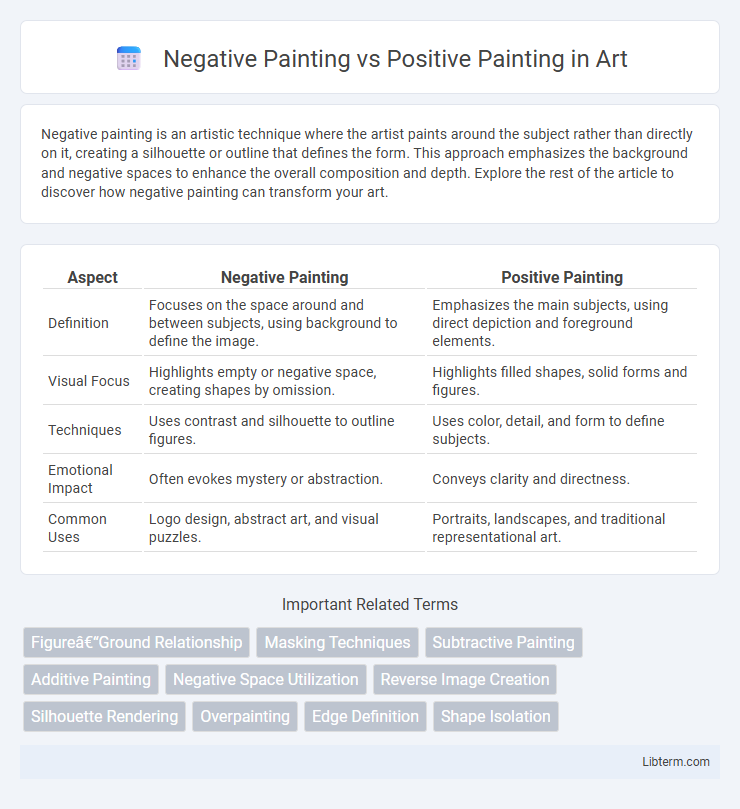Negative painting is an artistic technique where the artist paints around the subject rather than directly on it, creating a silhouette or outline that defines the form. This approach emphasizes the background and negative spaces to enhance the overall composition and depth. Explore the rest of the article to discover how negative painting can transform your art.
Table of Comparison
| Aspect | Negative Painting | Positive Painting |
|---|---|---|
| Definition | Focuses on the space around and between subjects, using background to define the image. | Emphasizes the main subjects, using direct depiction and foreground elements. |
| Visual Focus | Highlights empty or negative space, creating shapes by omission. | Highlights filled shapes, solid forms and figures. |
| Techniques | Uses contrast and silhouette to outline figures. | Uses color, detail, and form to define subjects. |
| Emotional Impact | Often evokes mystery or abstraction. | Conveys clarity and directness. |
| Common Uses | Logo design, abstract art, and visual puzzles. | Portraits, landscapes, and traditional representational art. |
Introduction to Negative and Positive Painting
Negative painting emphasizes painting the background or surrounding areas to define the subject through contrast, highlighting shapes and forms by leaving the subject unpainted or minimally painted. Positive painting involves directly painting the subject or focal elements, focusing on detailed brushwork and color application to bring the subject into prominence. Understanding these two approaches reveals distinct artistic techniques and visual effects that influence composition, depth, and viewer perception.
Defining Negative Painting Techniques
Negative painting techniques involve defining shapes by painting around the subject rather than filling in the subject itself, creating contrast through color and space. This approach emphasizes background manipulation to highlight the form indirectly, often using layers of washes or glazes in watercolors and acrylics. By focusing on the space surrounding the object, negative painting enhances depth and brings a dynamic, visually engaging balance between figure and ground.
Understanding Positive Painting Methods
Positive painting methods emphasize applying paint directly to the canvas to define shapes and forms, creating vibrant and distinct images through additive techniques. This approach often involves layering colors and focusing on light and shadow to build depth and dimension, enhancing the visual impact of the artwork. Artists utilizing positive painting prioritize precision and intentional brushwork to capture detailed subjects and vivid expressions.
Key Differences: Negative vs Positive Painting
Negative painting emphasizes the background or surrounding space to define the subject, often creating shapes by painting around them, while positive painting focuses directly on the subject itself with explicit brushstrokes and details. The key difference lies in approach: negative painting uses the absence of color or forms to highlight the figure, whereas positive painting relies on the presence of color and detail to create the image. This technique distinction impacts the visual perception and composition dynamics in art.
Artistic Effects Achieved by Negative Painting
Negative painting enhances artistic effects by creating striking contrasts and emphasizing surrounding shapes through strategic removal of color. This technique allows artists to define forms implicitly, adding depth and visual intrigue without relying on direct brushstrokes to outline subjects. The interplay of foreground and background achieved by negative painting enriches composition complexity, resulting in dynamic and engaging artwork.
Creative Possibilities with Positive Painting
Positive painting emphasizes applying colors directly onto the canvas, allowing vibrant layers and textures that enhance creativity through bold expression and detailed imagery. This technique offers artists freedom to experiment with color blending, brushwork, and composition, fostering innovative styles and dynamic visual effects. Embracing positive painting expands artistic potential by enabling precise control over shape definition and vibrant color interplay.
Tools and Materials for Both Painting Styles
Negative painting utilizes masking fluids, stencils, and fine brushes to preserve light areas by painting around them, often relying on transparent watercolors or inks on paper. Positive painting employs traditional brushes, palette knives, and thick acrylic or oil paints to build forms directly by applying color and texture onto the canvas. Both styles benefit from high-quality paper or canvas substrates but require distinct toolsets to achieve their characteristic effects.
Choosing the Right Technique for Your Artwork
Choosing between negative painting and positive painting techniques depends on the desired focus and composition of the artwork. Negative painting emphasizes the space around objects, creating forms through surrounding colors and shapes, which enhances depth and contrast. Positive painting focuses on directly rendering the subject with color and detail, ideal for highlighting intricate elements and vibrant focal points.
Common Challenges and Tips for Each Approach
Negative painting often struggles with maintaining precise edges and balancing the surrounding space, requiring artists to carefully plan color contrasts and control brush movements. Positive painting challenges include achieving accurate shapes and details without overworking the composition, making layer transparency and drying times critical. Tips for negative painting emphasize patience and using masking techniques, while positive painting benefits from clear focal points and incremental detail-building.
Which Style Suits Your Artistic Vision?
Negative painting emphasizes the space around the subject by painting the background first, creating shapes through contrast and often yielding a more abstract and spontaneous style. Positive painting focuses on defining the subject directly with filled-in shapes and clear outlines, offering control and precision ideal for detailed, realistic artworks. Choosing between these styles depends on whether your artistic vision favors expressive abstraction through background manipulation or detailed emphasis on the subject itself.
Negative Painting Infographic

 libterm.com
libterm.com